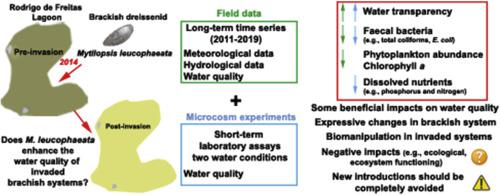Water Research ( IF 11.4 ) Pub Date : 2020-07-13 , DOI: 10.1016/j.watres.2020.116108 Raquel A F Neves 1 , Clarissa Naveira 1 , Igor Christo Miyahira 2 , Samira G M Portugal 3 , Natascha Krepsky 4 , Luciano N Santos 5

|
The dark false mussel Mytilopsis leucophaeata occurs as non-native species in Asia, Europe and South America. Despite the low population density usually found in its native range, M. leucophaeata forms dense clusters in newly invaded areas which lead to impacts on local organisms and environment. Some of the impacts of non-native species on newly colonized areas may be positive. However, despite the empirical evidences of increase in water transparency by freshwater dresseinids, the hypothesis that dark false mussel enhances the quality of brackish water has never been tested so far. Thus, the present study aimed to determine M. leucophaeata impacts on the water quality of a nutrient-enriched coastal lagoon by (1) analyzing a historical water dataset for pre- and post-invasion at Rodrigo de Freitas Lagoon (Brazil) and (2) experimentally testing dark false mussel direct effects on water quality. Historical field data evidenced significant lower phytoplankton abundance and chlorophyll a, and higher water transparency for the post-invasion period. These pattens were also supported by time-series analyses, which detected a decreasing trend for total coliforms density and an increased trend for dissolved oxygen over time. Moreover, time series indicated a gradual increase in lagoon water level with time, but none or minor changes were evidenced for floodgates operation routine, meteorological variables, and the frequency of sewage input. In microcosms, M. leucophaeata was effective to increase water transparency and decrease E. coli densities. The combination of field and laboratory data partially supported the hypothesis that M. leucophaeata invasion promoted an improvement in lagoon water quality, but increased phosphorus availability through excretion in microcosm assays. Management of dark false mussel populations seems to be a potential strategy for water quality improvement within already invaded systems where high sewage-enriched effluents are released. However, as non-native species often unbalance ecological relationships and functioning of the invaded ecosystems, new introductions of M. leucophaeata must be avoided.
中文翻译:

入侵物种对水生生态系统服务是否总是不利?深色假贻贝在受多重影响的城市沿海泻湖中对改善水质的作用。
深色假贻贝Mytilopsis leucophaeata在亚洲,欧洲和南美洲以非本地物种出现。尽管通常在其自然范围内发现的种群密度较低,但是白斑分支杆菌仍在新近入侵的地区形成密集的簇,这对当地的生物和环境产生了影响。非本地物种对新殖民地区的某些影响可能是积极的。然而,尽管有经验证据表明淡水海藻苷增加了水的透明度,但迄今尚未对深色假贻贝提高微咸水质量的假说进行过验证。因此,本研究旨在确定白带分枝杆菌(1)分析Rodrigo de Freitas泻湖(巴西)入侵前后的历史水数据集,以及(2)通过实验测试黑假贻贝对水质的直接影响,对营养丰富的沿海泻湖的水质产生影响。历史实地数据表明,浮游植物的丰度和叶绿素a明显较低。,并在入侵后提高了水的透明度。这些专利也得到了时间序列分析的支持,该分析发现总大肠菌群密度呈下降趋势,溶氧随时间呈上升趋势。此外,时间序列表明泻湖水位随时间逐渐增加,但是闸门的运行程序,气象变量和污水输入频率没有或只有很小的变化。在微观世界中,白斑分支杆菌可有效提高水的透明度并降低大肠杆菌的密度。野外和实验室数据的结合部分支持了白带分枝杆菌的假说入侵促进了泻湖水质的改善,但通过微观分析中的排泄增加了磷的利用率。在已经入侵的系统中,管理深色假贻贝种群似乎是改善水质的一项潜在策略,在该系统中,污水排放量很高。但是,由于非本地物种通常不平衡生态关系和被入侵的生态系统的功能,因此必须避免新引入白带分枝杆菌。











































 京公网安备 11010802027423号
京公网安备 11010802027423号